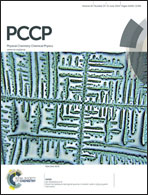Controlled morphology modulation of anodic TiO2 nanotubes via changing the composition of organic electrolytes
Abstract
Titanium dioxide (TiO2) nanotubes are prepared by electrochemical anodization using Ti metal foils under a DC bias of 30 V for 20 h. The electrolyte is a mixture of formamide (FA) and ethylene glycol (EG), which contains NH4F (0.3 wt%) and H2O (2.0 v%). The diameter and wall thickness of the nanotubes decrease with the increase of EG content, while the length first decreases with the increase of EG content and then increases again. An O-ring-like pattern is formed on the outer surface of TiO2 nanotubes upon the introduction of FA into the EG electrolyte, upon which the surface becomes rougher and rougher with increasing FA content. This is caused by the breaking and re-establishment of a double layer at the interface. All of the observed phenomena are closely related to the conductivity and viscosity of the electrolyte as well as the formation of hydrogen bond in the system. The proposed mechanism is confirmed by introducing hydroxyl ions into the pure EG electrolyte.


 Please wait while we load your content...
Please wait while we load your content...